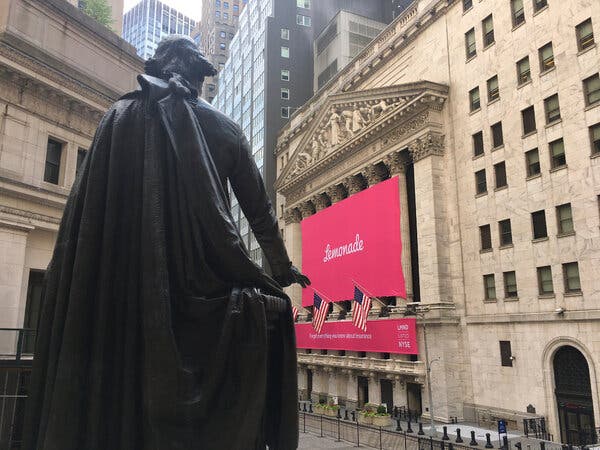Coinbase, a company that allows people and companies to buy and sell digital currencies, begins publicly trading on Wednesday, after its shares received a reference price of $250 each on Tuesday evening.
Coinbase, which makes money through transaction fees, estimated it took in $1.8 billion in revenue in the first three months of the year as crypto prices soared. On Wednesday, the fervor continued: Dogecoin, a cryptocurrency which started as a joke, jumped to a new high (albeit just 14 cents), and Bitcoin, the largest cryptocurrency, climbed above $64,000 to its own record high.
Shares in blockchain-linked companies also rose in premarket trading. Shares in Bit Digital, a Chinese bitcoin mining company traded in the United States, rose nearly 12 percent. Riot Blockchain rose about 1 percent.
Elsewhere in the Markets
-
Global stocks drifted on Wednesday as company earnings started to pour in. The S&P 500 dipped slightly after reaching another record on Tuesday. The Stoxx Europe 600 index was slightly higher.
-
Yields on 10-year U.S. Treasury notes rose 2 basis points, or 0.02 percentage points, to 1.63 percent.
-
Oil prices climbed. Futures for West Texas Intermediate, the U.S. crude benchmark, rose 1.6 percent to $61.10 a barrel.
Company Earnings
-
JPMorgan Chase fell 1 percent after the bank reported its best first quarter on record, but said demand for loans was “challenged.” Goldman Sachs rose nearly 1.5 percent after reporting investment banking revenue that beat analyst expectations.
-
SAP rose 4 percent after the German software company said revenue from its cloud business was growing and upgraded its forecast for full year earnings.
-
Shares in easyJet, the low-cost airline, rose 2 percent after it said it expected to increase flights from May and reported earnings for the six months through March that were better than analysts expected.
-
Tesco, the large British grocer, fell as much as 4.4 percent after the company reported a 20 percent decline in pretax profit because of the extra cost of operating stores and warehouses safely during the pandemic. The grocer also said it expected sales to decline as pandemic restrictions ease, but that this would improve profit margins.

Coinbase, the cryptocurrency exchange, is set to begin trading on the Nasdaq on Wednesday — and probably at a much higher valuation than the $65 billion preliminary estimate set last night. Here’s what you need to know about crypto’s move into the mainstream.
Why Coinbase matters
The company is the first major crypto business to trade publicly in the U.S. Its size means that its stock is likely to be held by mainstream index funds, giving average investors (indirect) exposure to the world of crypto. “Hopefully Coinbase going public and having its direct listing is going to be viewed as kind of a landmark moment for the crypto space,” Brian Armstrong, Coinbase’s chief executive, told Andrew in a CNBC interview.
It will instantly become a financial giant on Wall Street.
-
Even at $65 billion, Coinbase’s market value will exceed that of the stock exchanges its shares will trade on: Nasdaq’s market cap is $26 billion, while ICE, the parent company of the N.Y.S.E., is valued at $67 billion. And by the way, Goldman Sachs’s market value is $111 billion.
-
Coinbase is profitable, taking in $322 million last year — and an estimated $800 million in the first quarter this year alone. It also made significantly more revenue from trades (0.6 percent) than did the Nasdaq (0.009 percent) and ICE (0.011 percent).
But there are also giant risks.
-
Coinbase benefited hugely from a run-up in cryptocurrencies’ prices in recent months, and the company warned in its prospectus that its business was “substantially dependent on the prices of crypto assets and volume of transactions conducted on our platform.”
-
Skeptics think competition will eventually bring Coinbase’s fat margins down, though Mr. Armstrong asserted that he didn’t seen any sign of that happening yet. “Longer term, yes, I do think there could be fee compression, just like in every other asset class,” he told CNBC.

What a difference a year makes.
Last year, as the pandemic raged across the country, banks set aside billions of dollars to cushion themselves from an expected trail of economic devastation that they anticipated would bring job losses and an inability for borrowers to pay their debts from credit cards, mortgages and car loans.
But the American consumer proved to be surprisingly resilient, the country’s biggest banks said on Wednesday as they released big chunks of those cash provisions and surveyed the start to a year that has been marked by strong trading activity, improved consumer performance and a flurry of corporate deal-making.
Citing the vast government support for the economy, JPMorgan Chase’s chief executive, Jamie Dimon, suggested that the economy was on the verge of a boom. “We believe that the economy has the potential to have extremely robust, multi-year growth,” he said in a statement, attributing his bullishness to government spending on stimulus and infrastructure, supportive policies from the Federal Reserve and high hopes for the end of the pandemic. His bank, the biggest in the United States by assets, reported a fivefold rise in profit to $14.3 billion from $2.9 billion during the same period last year.
That surge was strengthened by the release of $5.2 billion in cash reserves, but also by gains in the bank’s business lines, where investment banking revenue rose 65 percent. Money-management services and trading activities also posted double-digit percentage rises.
Goldman Sachs and Wells Fargo also reported strong first-quarter results, thanks to some of the same dynamics. Goldman — a dominant player in banking and markets and a small player in consumer banking — reported a record profit of $6.8 billion, up from $1.2 billion in the same period last year, and a doubling of revenue to $17.7 billion from $8.7 billion. Those gains were attributed to strong gains in banking, markets and money management, along with other factors.
Wells Fargo earned $4.7 billion — up from $653 million a year ago — on stronger-than-expected revenue of $18.1 billion. The results “reflected an improving U.S. economy,” but low interest rates and sluggish demand for loans were a “headwind,” said Charlie Scharf, the bank’s chief executive. Earnings were up 19 percent to $2.2 billion. Home lending was also a bright spot for the bank.
Growing confidence in the economy led Wells to reduce its reserves for loan losses by $1.6 billion, and charge-offs ($523 million, down 44 percent from last year) fell to what the bank said was a historic low. The bank remains under a restriction from the Federal Reserve that limits its growth. Its efforts to improve its governance and appease regulators “is a multiyear effort and there is still much to do, but I am confident we are making progress, though it is not always a straight line,” Mr. Scharf said.
The company’s efforts to simplify its business have involved existing several markets. In the first quarter, it gained $208 million by selling its student loan portfolio.
Digital currency, once mocked as a tool for criminals and reckless speculators, is sliding into the mainstream. On Wednesday, Coinbase, a start-up that allows people to buy and sell cryptocurrencies, goes public on Nasdaq, marking the biggest step yet toward wider acceptance.
From Crypto Art to Trading Cards, Investment Manias Abound
Each market frenzy seems crazier than the last. But all have the same roots.
Why an Animated Flying Cat With a Pop-Tart Body Sold for Almost $600,000
A fast-growing market for digital art, ephemera and media is marrying the world’s taste for collectibles with cutting-edge technology.
Coinbase Users Say Crypto Start-Up Ignored Their Pleas for Help
As Coinbase prepares to be the first major cryptocurrency company to go public, it is struggling with basic customer service, users said.
Cryptocurrency Start-Up Underpaid Women and Black Employees, Data Shows
An analysis of internal pay data at the San Francisco company Coinbase shows disparities that were much larger than those in the tech industry.

Toshiba announced on Wednesday the resignation of its top executive, Nobuaki Kurumatani, a move that comes as the Japanese conglomerate faces a potential buyout and a shareholder-initiated investigation into its management practices.
The board appointed Satoshi Tsunakawa — the current chairman and previous president — to replace Mr. Kurumatani, the company said in a brief statement. It did not explain the reason for the change.
Toshiba, once among the crown jewels of Japanese industry, a maker of products ranging from personal printers to railroad locomotives, has struggled in recent years, overshadowed by the legacy of a major accounting scandal and its acquisition of the American nuclear power company Westinghouse, which declared bankruptcy in 2017.
Seeking to rebuild, Toshiba looked for a new leader from outside its own ranks, and in 2018 it appointed Mr. Kurumatani, an executive with CVC Capital Partners, a private equity company based in Europe, as chief executive. It was an unusual decision for a company that had long been headed by company insiders. Last year, he was appointed president, solidifying his control over the firm.
During a news conference Wednesday, board member Osamu Nagayama deflected questions about the resignation, saying that Mr. Kurumatani, 63, had been considering the move for months and had come to the decision with his family. Unusually, Mr. Kurumatani did not make an appearance, but in a letter that was read aloud to reporters, he said he had chosen to resign after “achieving my mission to rebuild the company.”
The announcement on Wednesday followed months of unrest at Toshiba as disgruntled shareholders agitated for reforms aimed at improving the company’s performance and increasing its value.
Toshiba investors tried to shake up the company’s management at the annual general meeting last summer. But Mr. Kurumatani was re-elected — albeit with less than 60 percent of the vote — following a showdown that angered some key shareholders and raised questions about whether the company had inappropriately interfered in the decision.
Effissimo Capital Management, a Singapore-based hedge fund that holds about 10 percent of the company and had led the campaign to unseat its management team, subsequently called for an investigation into the outcome. Other shareholders agreed, voting, over management’s objections, to begin an independent inquiry in March.
Earlier this month, Toshiba announced that it had received a buyout offer from CVC Capital Partners for a reported $20 billion, a substantial premium on the company’s share price. The offer has raised questions of conflict of interest, as Mr. Kurumatani had previously served as president of CVC’s Japan office.
In recent years, Japanese companies have increasingly been the focus of activist investors from abroad, who believe that sclerotic management and opaque governance practices have prevented many of Japan’s blue chip firms from achieving their full value.
Hisako Ueno contributed reporting.

Dozens of companies are suddenly paying more attention to individual investors.
Small investors who buy single stocks have not been a major force in financial markets for the better part of half a century. They were growing in influence before the pandemic, partly because of the popularity of free trading apps such as Robinhood.
But with millions of Americans stuck at home during the pandemic, the trading trend escalated, Matt Phillips reports for The New York Times.
“Retail trading now accounts for almost as much volume as mutual funds and hedge funds combined,” Amelia Garnett, an executive at Goldman Sachs’s Global Markets Division, said on a recent podcast produced by the firm. “So, the retail impact is really meaningful right now.”
Tesla has long eschewed traditional communications with Wall Street. Ark Investment Management — the high-flying, tech-focused exchange-traded fund company run by the investor Cathie Wood — and Palantir Technologies, are also trying to reach small investors directly.
Before Lemonade, a company that sells insurance to consumers online, went public in July, it went on a traditional tour of Wall Street, meeting big investors and talking up its prospects. However, the company has since discovered that more than half of its shares are held by small investors, excluding insiders who own the stock, said Daniel Schreiber, its chief executive.
That has prompted a strategy adjustment. In addition to spending time communicating with analysts whose “buy” or “sell” ratings on the stock can move its price, Mr. Schreiber said, he has made a point of doing interviews on podcasts, websites and YouTube programs popular with retail investors.
“I think that they are, today, far more influential on, and command far more following in terms of stock buying or selling power than the mighty Goldman Sachs does,” Mr. Schreiber said. “And we’ve seen that in our own stock.”
-
The first woman to lead CBS News, Susan Zirinsky, is expected to announce that she is stepping down from the presidency of the network’s news division, possibly as soon as this week, a person with knowledge of the plan said on Tuesday. Ms. Zirinsky is expected to sign a production deal with the network’s parent company, ViacomCBS, to work on broadcast, cable and streaming programs, according to the person with knowledge of the details of her departure. Ms. Zirinsky, 69, was appointed in January 2019.
-
Epic Games, the video game developer that produced the hit game Fortnite, said Tuesday that it had raised $1 billion in funding, valuing the company at $28.7 billion. Sony, the creator of the PlayStation game console, invested $200 million, Epic said, and Appaloosa Management, Baillie Gifford and Fidelity Management were also among the investors. Epic’s most recent funding round came last summer, when it raised $1.78 billion to value the company at $17.3 billion. Sony invested $250 million at the time.

Two months after the storm crippled large swaths of Texas, insurers are sketching out a legal strategy to pin the costs on utilities and power companies that they say failed to adequately prepare for bitterly cold weather.
At stake could be more than $10 billion in insured losses for insurers and their business partners, as well as almost-certain premium increases for property owners if the insurers have to pay for the damage themselves, Mary Williams Walsh reports for The New York Times.
-
The insurers say the power companies and utilities failed to prepare for a major winter storm, even though past cold snaps and climate-change data had made the danger clear.
-
In 1989 and 2011, wintry weather caused so much damage that state and federal regulators spent months investigating the causes and issued detailed recommendations for hardening the electrical system against storms. “It doesn’t look like anybody did anything,” said Lawrence T. Bowman, a lawyer in Dallas who represents insurers in liability disputes.
But decades of deregulation have made the state’s power grid a dizzying web of companies that could make determining fault tricky. Insurers will also have to show that the damage was the result of “gross negligence.” And there are dozens of small companies in the supply chain — some of which have gone bankrupt since the storm — that interact with one another in myriad ways.






